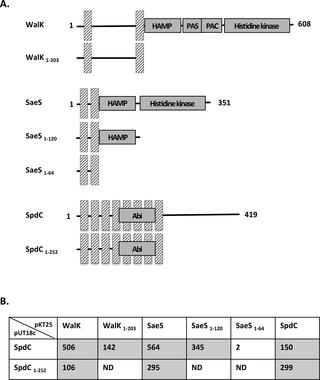PLoS Pathogens ( IF 6.7 ) Pub Date : 2018-03-15 , DOI: 10.1371/journal.ppat.1006917 Olivier Poupel , Caroline Proux , Bernd Jagla , Tarek Msadek , Sarah Dubrac

|
The success of Staphylococcus aureus, as both a human and animal pathogen, stems from its ability to rapidly adapt to a wide spectrum of environmental conditions. Two-component systems (TCSs) play a crucial role in this process. Here, we describe a novel staphylococcal virulence factor, SpdC, an Abi-domain protein, involved in signal sensing and/or transduction. We have uncovered a functional link between the WalKR essential TCS and the SpdC Abi membrane protein. Expression of spdC is positively regulated by the WalKR system and, in turn, SpdC negatively controls WalKR regulon genes, effectively constituting a negative feedback loop. The WalKR system is mainly involved in controlling cell wall metabolism through regulation of autolysin production. We have shown that SpdC inhibits the WalKR-dependent synthesis of four peptidoglycan hydrolases, SceD, SsaA, LytM and AtlA, as well as impacting S. aureus resistance towards lysostaphin and cell wall antibiotics such as oxacillin and tunicamycin. We have also shown that SpdC is required for S. aureus biofilm formation and virulence in a murine septicemia model. Using protein-protein interactions in E. coli as well as subcellular localization in S. aureus, we showed that SpdC and the WalK kinase are both localized at the division septum and that the two proteins interact. In addition to WalK, our results indicate that SpdC also interacts with nine other S. aureus histidine kinases, suggesting that this membrane protein may act as a global regulator of TCS activity. Indeed, using RNA-Seq analysis, we showed that SpdC controls the expression of approximately one hundred genes in S. aureus, many of which belong to TCS regulons.
中文翻译:

SpdC是一种新型毒力因子,可控制金黄色葡萄球菌中的组氨酸激酶活性
作为人类和动物病原体的金黄色葡萄球菌的成功,源于其快速适应各种环境条件的能力。两部分系统(TCS)在此过程中起着至关重要的作用。在这里,我们描述了一种新型的葡萄球菌毒力因子SpdC,一种Abi结构域蛋白,参与信号传感和/或转导。我们发现了WalKR必需的TCS和SpdC Abi膜蛋白之间的功能联系。spdC的表达由WalKR系统正调控,而SpdC反过来控制WalKR regulon基因,有效地构成一个负反馈环。WalKR系统主要通过调节自溶素的产生来控制细胞壁的代谢。我们已经表明,抑制发会四种肽聚糖水解酶,SCED,SSAA,LytM和ATLA,以及撞击WalKR依赖性合成小号。金黄色葡萄球菌对溶葡萄球菌素和细胞壁抗生素(如奥沙西林和衣霉素)的耐药性。我们还显示了S需要SpdC 。鼠败血症模型中的金黄色葡萄球菌生物膜形成和毒力。在E中使用蛋白质-蛋白质相互作用。大肠杆菌以及S中的亚细胞定位。在金黄色葡萄球菌中,我们显示SpdC和WalK激酶均位于分裂间隔处,并且这两种蛋白质相互作用。除WalK外,我们的结果表明SpdC还与其他9个S相互作用。金黄色的组氨酸激酶,提示该膜蛋白可能是TCS活性的整体调节剂。确实,使用RNA-Seq分析,我们显示SpdC控制S中大约100个基因的表达。金黄色葡萄球菌,其中许多属于TCS调节子。


























 京公网安备 11010802027423号
京公网安备 11010802027423号